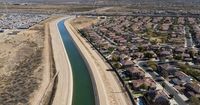The Colorado River, a lifeline for millions across the American West, is facing a crisis that experts say can no longer be ignored. On September 14, 2025, a group of prominent scholars released a report warning that the river’s two largest reservoirs—Lake Mead and Lake Powell—are so depleted that another dry year could push them to dangerously low levels. Their urgent message: the Trump administration must step in and mandate substantial cutbacks in water use across the seven states that depend on the river—California, Arizona, Nevada, New Mexico, Colorado, Utah, and Wyoming.
“We’ve got a real problem, and we ought to deal with it sooner rather than later,” said Jack Schmidt, director of Utah State University’s Center for Colorado River Studies and a co-author of the analysis, as cited by the Los Angeles Times. “Everybody needs to be looking at ways to cut right now.”
The Colorado River is more than just a water source; it sustains cities from Denver to San Diego, supplies 30 Native tribes, and irrigates farming communities stretching from the Rocky Mountains to northern Mexico. Yet for decades, the river has been overused, with its reservoirs declining dramatically amid persistent drought conditions since 2000. Research, as highlighted in the report, points to climate warming—largely driven by fossil fuel use—as a major factor intensifying these prolonged dry years.
The 2024-2025 winter delivered a particularly meager snowpack in the Rockies, further straining the river. The researchers analyzed the most recent federal data and concluded that if the upcoming winter is equally dry, the river’s major reservoirs will approach critically low levels unless major reductions in water usage are enacted. “The results are grim,” the experts wrote in their report, released on September 11, 2025. They calculated that if next year mirrors this year’s conditions, total water use would exceed the river’s natural flow by at least 3.6 million acre-feet—almost as much as all of California’s water use last year. Under this scenario, water use would surpass the river’s flow by more than one-fourth.
While a snowy winter could offer some relief, the federal government’s latest seasonal forecast predicts the Southwest will likely experience above-average temperatures and below-average precipitation in the coming months. That’s not the news water managers wanted to hear. The researchers called for the Interior Department, which oversees the river’s dams, to “take immediate action.” As they put it: “Avoiding this possible outcome requires immediate and substantial reductions. Taking steps now to decrease consumptive uses across the Basin will reduce the need to implement draconian measures in the following years.”
Lake Mead, near Las Vegas and the nation’s largest reservoir, is now just 31% full. Upstream from the Grand Canyon, Lake Powell, the country’s second-largest reservoir, sits at 29% capacity. Federal officials are determined to keep Lake Powell above a critical threshold; if levels drop too low, water can only pass downstream through Glen Canyon Dam’s four 8-foot-wide low-level bypass tubes. These tubes, federal officials warn, could become a bottleneck, limiting the water that reaches California, Arizona, Nevada, and Mexico. To make matters worse, damage discovered inside the tubes in 2024 could further restrict water flow if reservoir levels continue to fall.
The researchers’ analysis focused on what they termed “realistically accessible water” in Lake Mead and Lake Powell, using critical thresholds established by federal managers. “A near term crisis is unfolding before our eyes,” they wrote in a blog post announcing the findings. “The gap between ongoing water use and the reality of how much water actually flows in the Colorado River poses a serious near term threat.”
It’s not all bad news—at least, not yet. A heavy snowpack in the Rockies in 2023 brought some much-needed relief to the depleted reservoirs, and 2024 saw near-average river flows compared to the last 25 years. But that brief respite faded quickly: in 2025, the snowmelt runoff in the river’s upper basin was only about 70% of the historical average.
Meanwhile, representatives of the seven basin states are locked in difficult negotiations to develop new rules for managing shortages after 2026, when current agreements expire. While those talks drag on, Schmidt and his fellow researchers insist the time for action is now. “We think that [the Bureau of] Reclamation needs to address all this right now and begin to implement cuts,” Schmidt told reporters, emphasizing that reductions should be shared among all seven states.
Efforts to save water have been underway for several years. The states have adopted a series of incremental plans to try to keep the reservoirs from reaching perilously low levels. For example, farmers in California’s Imperial Valley have voluntarily left some hay fields dry and unplanted in exchange for payments through federally funded programs established during the Biden administration. But with the change in administration, experts are unsure if the Trump administration will provide additional funding for such water-saving efforts.
Alyse Sharpe, spokesperson for the Interior Department, said the Bureau of Reclamation is closely monitoring conditions. As the expiration of the current rules approaches, she stated, “we are actively engaging with our partners across the Colorado River Basin to develop new long-term operational agreements.” Sharpe added, “This is a moment that demands urgency, collaboration and transparency. We remain committed to working with Basin states, tribes, Mexico and stakeholders to ensure a sustainable and resilient future for the Colorado River system.”
For many, the report serves as a stark wake-up call. Anne Castle, a senior fellow at the University of Colorado Law School’s Getches-Wilkinson Center and a co-author of the report, said its purpose is to alert water managers throughout the Colorado River Basin to the urgency of the situation. “The reductions in water use will be politically difficult,” Castle acknowledged, “but the seven states have a history—with prodding from the federal government—of ultimately coming to agreement around solutions.” She stressed that the focus now should be “on this short-term management issue so that we don’t find ourselves in a deeper hole.”
While the political and logistical challenges ahead are daunting, the facts are clear: without immediate and substantial reductions in water use, the Colorado River’s reservoirs could soon reach levels that threaten water supplies for millions of people, Native tribes, and farmers. The choices made in the coming months will determine whether the region can avert a full-blown crisis—or if the warnings of scientists, long ignored, will finally come to pass.




